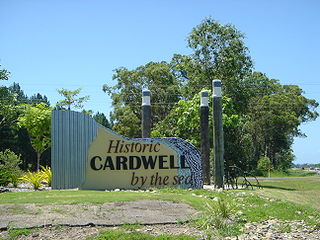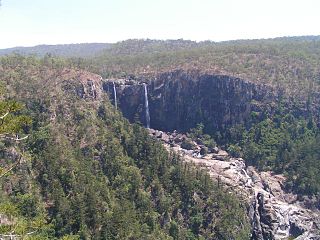
Hinchinbrook Island lies east of Cardwell and north of Lucinda, separated from the northern coast of Queensland, Australia by the narrow Hinchinbrook Channel. Hinchinbrook Island is part of the Great Barrier Reef Marine Park and wholly protected within the Hinchinbrook Island National Park, except for a small and abandoned resort. It is the largest island on the Great Barrier Reef. It is also the largest island national park in Australia.

Cardwell is a tropical coastal town and locality in the Cassowary Coast Region in Far North Queensland, Australia. In the 2016 census, Cardwell had a population of 1,309 people. The Bruce Highway National Highway 1 and the North Coast railway line are the dominant transport routes; connecting with the Queensland provincial cities of Cairns and Townsville. Cardwell suffered significant damage from Cyclone Yasi, a category 5 cyclone, in February 2011.

The Herbert River is a river located in Far North Queensland, Australia. The southernmost of Queensland's wet tropics river systems, it was named in 1864 by George Elphinstone Dalrymple explorer, after Robert George Wyndham Herbert, the first Premier of Queensland.

The Koreng, also spelled Goreng, are an indigenous Noongar people of south-west of Western Australia.
The Manbarra, otherwise known as the Wulgurukaba, are Aboriginal Australian people, and the traditional custodians of Palm Island in Queensland.
Warrgamay is an extinct Australian Aboriginal language of northeast Queensland. It was closely related to Dyirbal.
The Nyawigi people, also spelt Nyawaygi, Nywaigi, or Nawagi, are an Aboriginal Australian people whose original country was around Halifax Bay in Far North Queensland.
The Ngajanji, also written Ngadyan, and Ngadjon-Jii are an Indigenous Australian people of the rainforest region south of Cairns, in northern Queensland. They form one of 8 groups, the others being Yidin, Mamu, Dyirbal, Girramay, Warrgamay, Waruŋu and Mbabaram, of the Dyirbal tribes.
The Girramay were an Australian Aboriginal tribe of northern Queensland.
The Maia were an indigenous Australian tribe of Western Australia.
The Wangkumarra are an indigenous people of the state of Queensland, Australia.
The Kareldi was a name assigned by Norman Tindale to Aboriginal Australian peoples of the state of Queensland. There were two groups that went by this name, the Garandi (Karandi), after the Garandi language, and the Gkuthaarn, after the Gkuthaarn language. It is not clear if they constituted a single people, but it appears that there were two dialects in the same area.
The Karanja (Karanya) were an indigenous Australian people of the state of Queensland.
The Wanyuru were an indigenous Australian people of the state of Queensland.
The Biyaygiri, also known as Bandjin, were an Aboriginal Australian people of northern Queensland.
The Bindal are an indigenous Australian people of the state of Queensland.
The Yalarnnga, also known as the Jalanga, were an indigenous Australian people of the state of Queensland.
The Yungkurara were an indigenous Australian people of the state of Queensland.
The Iwaidja are an indigenous Australian people of the Northern Territory.

Hawkins Creek is a rural locality in the Shire of Hinchinbrook, Queensland, Australia. In the 2016 census, Hawkins Creek had a population of 216 people.